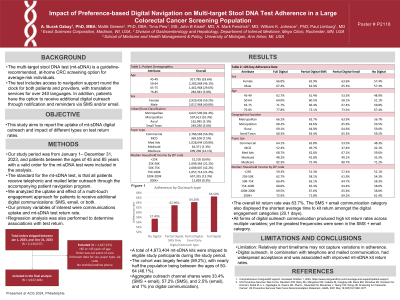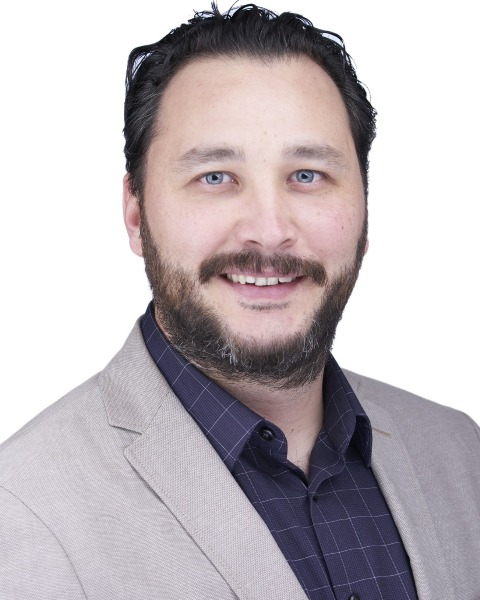Monday Poster Session
Category: Colorectal Cancer Prevention
P2118 - Impact of Preference-Based Digital Navigation on Multi-Target Stool DNA Test Adherence in a Large Colorectal Cancer Screening Population
Monday, October 28, 2024
10:30 AM - 4:00 PM ET
Location: Exhibit Hall E

Has Audio

A. Burak Ozbay, MBA, PhD
Exact Sciences
Lake Forest, IL
Presenting Author(s)
A. Burak Ozbay, MBA, PhD1, Mallik Greene, PhD2, Timo Pew, MS2, John B. Kisiel, MD3, A Mark Fendrick, MD4, Will K. Johnson, PhD, MSc5, Paul Limburg, MD, MPH6
1Exact Sciences, Lake Forest, IL; 2Exact Sciences, Madison, WI; 3Mayo Clinic, Rochester, MN; 4University of Michigan, Ann Arbor, MI; 5Exact Sciences Corporation, Madison, WI; 6Exact Sciences, Rochester, MN
Introduction: The multi-target stool DNA test (mt-sDNA) is a guideline-recommended, at-home CRC screening option for average-risk individuals. The test includes access to navigation support round the clock for both patients and providers, with translation services for over 240 languages. In addition, patients have the option to receive additional digital outreach through notification and reminders via SMS and/or email. Herein, we report the uptake of mt-sDNA digital outreach and impact of different types on test return rates.
Methods: Our study period was from January 1– December 31, 2023, and patients between the ages of 45 and 85 years with a valid order for the mt-sDNA test were included in the analysis. The standard for the mt-sDNA test, is that all patients receive telephonic and mailed letter outreach through the accompanying patient navigation program. We analyzed the uptake and effect of a multi-touch engagement approach for patients to receive additional digital communications: SMS, email, or both. Our primary variables of interest were communications uptake and mt-sDNA test return rate. Regression analysis was also performed to determine associations with test return.
Results: A total of 4,973,404 mt-sDNA kits were shipped to eligible study participants during the study period. The cohort was largely female (59.2%), with nearly half the population being between the ages of 50-64 (46.1%). Aggregate outreach channel shares were 33.4% (SMS + email), 57.2% (SMS), and 2.5% (email), and 7% (no digital communication). The overall kit return rate was 63.7%. Within communication type, return rates were 66.5% (SMS + email), 62.9% (SMS), and 64.2% (email), compared to no digital communication (57.4%) (p < 0.005). The SMS + email communication category also displayed the shortest average time to kit return amongst the digital engagement categories (20.1 days). All forms of digital outreach communication produced high kit return rates across multiple variables; yet the greatest frequencies were seen in the SMS + email category.
Discussion: The data show that digital outreach, in combination with telephone and mailed communication, had widespread acceptance and was associated with improved mt-sDNA kit return rates.
Disclosures:
A. Burak Ozbay, MBA, PhD1, Mallik Greene, PhD2, Timo Pew, MS2, John B. Kisiel, MD3, A Mark Fendrick, MD4, Will K. Johnson, PhD, MSc5, Paul Limburg, MD, MPH6. P2118 - Impact of Preference-Based Digital Navigation on Multi-Target Stool DNA Test Adherence in a Large Colorectal Cancer Screening Population, ACG 2024 Annual Scientific Meeting Abstracts. Philadelphia, PA: American College of Gastroenterology.
1Exact Sciences, Lake Forest, IL; 2Exact Sciences, Madison, WI; 3Mayo Clinic, Rochester, MN; 4University of Michigan, Ann Arbor, MI; 5Exact Sciences Corporation, Madison, WI; 6Exact Sciences, Rochester, MN
Introduction: The multi-target stool DNA test (mt-sDNA) is a guideline-recommended, at-home CRC screening option for average-risk individuals. The test includes access to navigation support round the clock for both patients and providers, with translation services for over 240 languages. In addition, patients have the option to receive additional digital outreach through notification and reminders via SMS and/or email. Herein, we report the uptake of mt-sDNA digital outreach and impact of different types on test return rates.
Methods: Our study period was from January 1– December 31, 2023, and patients between the ages of 45 and 85 years with a valid order for the mt-sDNA test were included in the analysis. The standard for the mt-sDNA test, is that all patients receive telephonic and mailed letter outreach through the accompanying patient navigation program. We analyzed the uptake and effect of a multi-touch engagement approach for patients to receive additional digital communications: SMS, email, or both. Our primary variables of interest were communications uptake and mt-sDNA test return rate. Regression analysis was also performed to determine associations with test return.
Results: A total of 4,973,404 mt-sDNA kits were shipped to eligible study participants during the study period. The cohort was largely female (59.2%), with nearly half the population being between the ages of 50-64 (46.1%). Aggregate outreach channel shares were 33.4% (SMS + email), 57.2% (SMS), and 2.5% (email), and 7% (no digital communication). The overall kit return rate was 63.7%. Within communication type, return rates were 66.5% (SMS + email), 62.9% (SMS), and 64.2% (email), compared to no digital communication (57.4%) (p < 0.005). The SMS + email communication category also displayed the shortest average time to kit return amongst the digital engagement categories (20.1 days). All forms of digital outreach communication produced high kit return rates across multiple variables; yet the greatest frequencies were seen in the SMS + email category.
Discussion: The data show that digital outreach, in combination with telephone and mailed communication, had widespread acceptance and was associated with improved mt-sDNA kit return rates.
Disclosures:
A. Burak Ozbay: Exact Sciences – Employee, Stock Options.
Mallik Greene: exact sciences – Employee.
Timo Pew: Exact Sciences – Employee, Stock-publicly held company(excluding mutual/index funds).
John Kisiel: Exact Sciences – Advisor or Review Panel Member, Advisory Committee/Board Member, Consultant, Grant/Research Support, Intellectual Property/Patents, all paid to Mayo Clinic, Royalties.
A Mark Fendrick: Exact Sciences – Advisory Committee/Board Member, Consultant.
Will Johnson: Exact Sciences Corporation – Employee. Exact Sciences Corporation – Employee, Stock-publicly held company(excluding mutual/index funds). Exact Sciences Corporation – Stock-publicly held company(excluding mutual/index funds).
Paul Limburg: Exact Sciences Corporation – Consultant, Employee, Stock-publicly held company(excluding mutual/index funds).
A. Burak Ozbay, MBA, PhD1, Mallik Greene, PhD2, Timo Pew, MS2, John B. Kisiel, MD3, A Mark Fendrick, MD4, Will K. Johnson, PhD, MSc5, Paul Limburg, MD, MPH6. P2118 - Impact of Preference-Based Digital Navigation on Multi-Target Stool DNA Test Adherence in a Large Colorectal Cancer Screening Population, ACG 2024 Annual Scientific Meeting Abstracts. Philadelphia, PA: American College of Gastroenterology.
